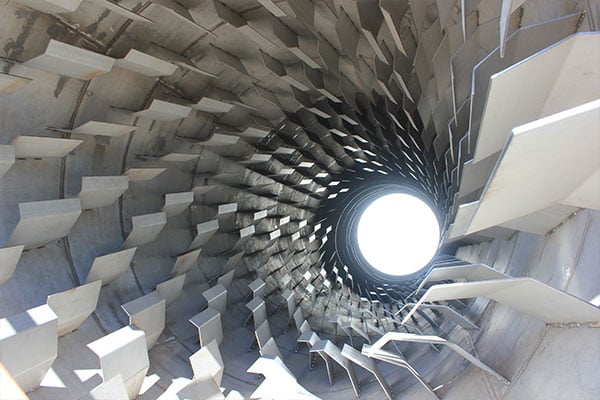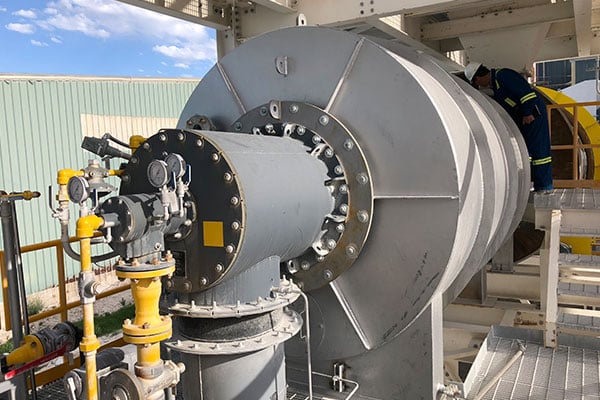Recovering oil prices have again made the extraction of oil and natural gas from shale formations profitable, prompting another surge in activity around recovering hydrocarbons via hydraulic fracturing.
This has created a subsequent increase in the need for sand dryers, particularly as companies look to build new facilities to support the in-basin sand trend. And while frac sand drying may appear a simple task, the industry has learned through experience that there is much more to this industrial process than meets the eye.
When it comes to frac sand drying, there are a number of factors that will need to be considered throughout the dryer design process, making dryers not designed around these characteristics especially inferior.
Note: The considerations listed below are specific to rotary dryers, which have become the industry standard in drying frac sand. For more information on the shift from fluid bed dryers to rotary dryers and the changing trends around frac sand drying, see our article, Evolution of the Frac Sand Dryer.
Characteristics of Frac Sand
With the frenzy around frac sand, it might seem that just about any sand can be pumped down a hydraulically-fractured well, but on the contrary, sand is required to meet a number of stringent standards in order to be considered suitable for use as a “frac sand” proppant.
Frac sand presents a number of characteristics that can make processing it efficiently a difficult endeavor. It’s critical that the drying system is designed with these considerations in mind to allow for maximum equipment life, efficient processing, and a quality frac sand product.
The material-specific characteristics of frac sand that must be considered during dryer design are listed below.
Abrasiveness
Not surprisingly, sand destined for use as a proppant is highly abrasive. Unfortunately, this abrasiveness can wreak havoc on an ill-prepared industrial dryer (among other processing and handling equipment), requiring careful modifications during the design phase to minimize its effects.
Silica/Quartz sand rates at 6-7 on the Mohs hardness scale, right alongside porcelain and titanium dioxide. When combined with the high throughput of frac sand drying plants, this abrasivity can quickly lead to excessive wear if not prepared for.
For this reason, frac sand dryers need to be constructed of heavy-duty materials capable of withstanding these rigorous demands. This often means constructing the dryer shell and other components out of stainless steel or specialty alloys instead of the more commonly employed carbon steel.
High Bulk Density
The bulk density of a material, measured in pounds per cubic foot (lbs/ft3), will comprise the operational load placed on the equipment, thereby influencing the mechanical components such as bearings, drive train, trunnion wheels, tires, and the motor.
Frac sand has a high bulk density of approximately 100 lbs/ft3. Again, in combination with the high throughput, this high weight-per-volume ratio requires the drying system to be engineered and built for a substantial operational load.
For example, while there are many options to choose from for the equipment’s drive assembly, the gear and pinion assembly is the best choice in most cases. The gear and pinion drive is ideal in heavy-duty settings running above 75 horsepower. This drive assembly style not only wears better under rigorous conditions, but it also requires less maintenance – ideal for the frac sand processing environment.
The selection of an inferior drive assembly would likely result in frequent and excessive downtime, as the machine would not be capable of handling such a heavy operational load.
Heat Transfer
Frac sand carries its moisture largely on the surface of the particle. As the moisture drops below a critical point, however, it becomes harder to extract – a phenomenon known as driving force. This means that a majority of the moisture is easily drawn out at the onset of drying, but after a certain point, the remaining moisture becomes more difficult to draw out.
In this case, a counter current air flow configuration optimizes drying efficiency by putting the driest material (or rather, the material at its most difficult drying point) in contact with the hottest combustion gases to help counteract this driving force.
FEECO also employs custom flight (material lifter) designs to further improve the heat transfer between the material and air flow. Flights affixed to the interior of the drum pick up material, carrying it as the drum rotates, and then dropping it through the air stream in a pattern known as the material curtain.

Frac sand dryer flights
Particle Size Distribution
Frac sand is available in a number of grades, but in general, is a very fine material. This fineness, while optimal for use as a proppant, can cause problems if a dryer is not designed to work around it.
The fine particle size of the sand allows it to become “entrained,” or picked up and carried out of the drum to the dryer’s exhaust system – an unacceptable process inefficiency.
Many drying system providers will counteract this issue by utilizing a drum that is larger in diameter, so air flow velocity can be decreased to reduce the potential for entrainment. However, as FEECO has demonstrated, by manipulating these key design parameters and modifying the discharge breeching design (knockout chamber), this carryover can be significantly reduced, while still maintaining a high throughput (in excess of 300 TPH in a single unit). The smaller drum diameter also reduces the expense of the equipment.
Natural Variation
As a naturally occurring mineral, sand exhibits variation in particle size distribution and moisture content. While this variation is to be expected, it can make processing a challenge in some cases, largely, if the appropriate dryer type has not been selected.
Rotary dryers and fluid bed dryers have traditionally been the primary industrial drying systems used for processing frac sand, but the industry is increasingly in favor of the rotary type, in large part, due to this unavoidable variation.
Fluid bed dryers are highly sensitive to variation in both particle size and moisture content. They require feedstock that is as uniform as possible; the more variation, the more upsets likely to be encountered. Conversely, rotary dryers are highly tolerant of such variation and are known for their ability to produce uniform results despite as much.
Emissions & Dust Control
Regulatory action concerning emissions around frac sand continues to become more stringent. Never has it been more important to minimize fugitive dust and chemical compounds such as CO and NOx.
Dust emissions from a dryer can be curtailed through the selection of the proper seal where the dryer meets the inlet and discharge breechings, while CO and NOx emissions can be minimized through burner selection.
Product Integrity
It’s important when working with frac sand that critical breakdown temperature be avoided in order to maintain product integrity. This can be done through the use of a combustion chamber, which, when designed properly, prevents the contact between the flame and the material.
Combustion chambers also help to reduce drying costs, because they promote a more complete combustion of the fuel source. This also results in further enhanced uniformity of drying results.

Rotary dryer burner and combustion chamber
Conclusion
The frac sand drying process is far from the simple task that many perceive it to be, requiring an engineered drying system backed by experience in order to prolong equipment life, maximize efficiency, and produce a quality, uniform end product for use in the hydraulic fracturing process.
FEECO has been an industry expert in the production of high quality, efficient rotary dryers since 1951. With rotary dryers in use around the world in various industries, our custom dryers have become known for their quality craftsmanship, efficient operation, and superior engineered design, and have proven themselves to be the workhorse of the industry, time after time. Not surprisingly, our heavy-duty frac sand dryers have come to be relied upon by many of the industry’s top producers.
For more information on our frac sand drying systems, contact us today.



